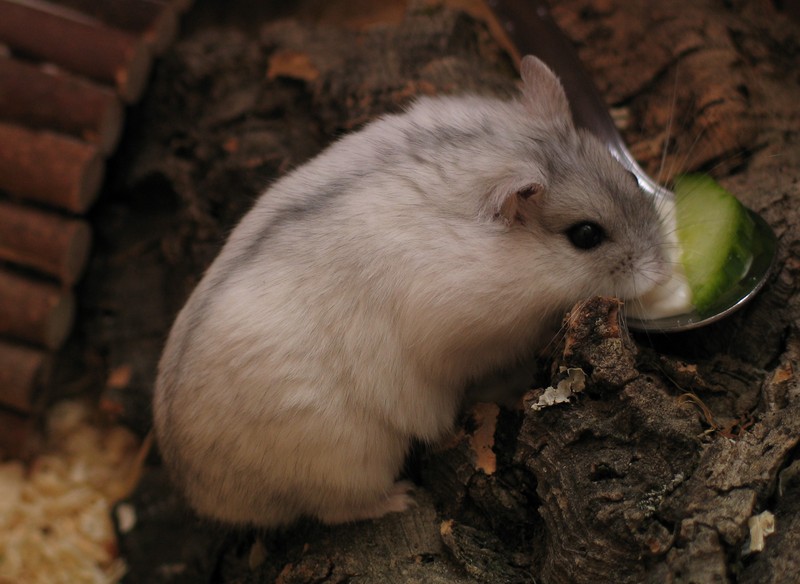|
Winter White Russian Dwarf Hamster (Phodopus sungorus) - Wiki
| 제목: | Winter White Russian Dwarf Hamster (Phodopus sungorus) - Wiki
| |

| 해상도: 2356x1720
파일크기: 680070 Bytes
등록시간: 2006:12:20 20:09:58
|
Winter white Russian dwarf hamster
From Wikipedia, the free encyclopedia
[Photo] Dwarf Winter White Russian Hamster. Deutsch: Dsungarischer Zwerghamster in der Fellfarbe Perlmutt, Suomi: Ven??j??nk????pi??hamsteri, English: Dwarf Winter White Russian Hamster, Nederlands: Russische dwerghamster. Date November 2005. Author Dirk Goldhahn.
Winter White Russian hamsters are a species of hamster in the genus Phodopus. They are typically half the size of the better-known Syrian hamster, and therefore called dwarf hamsters along with all Phodopus species. Features include a typically thick dark gray dorsal stripe and furry feet. The tail is so short that it hardly shows when the hamster is sitting. As winter approaches and the days get shorter, Winter Whites' dark fur greys until it is almost completely white (hence the name). In the wild, this adaptation helps them evade predators in the snow covered Steppes of winter. They live mainly in Siberia and are also found in Dzungaria, Kazakhstan, Mongolia and Manchuria.
Up until recently, it was debated whether the Winter White hamster was a sub-species of the Campbell's (Phodopus campbelli) or not; however, it has now been proven that the Winter whites are of their own species, Phodopus sungorus.
Winter White Russian hamsters as pets
They are often found on the pet market, in Europe and Asia more so than in the U.S.. They are rarely found in pet stores in Canada. Care is similar to that of the Campbell's hamster. Winter White hamsters generally make excellent pets. However, a larger Syrian hamster would be more suitable for younger children as they can be handled more clumsily. Winter White hamsters should not be fed food containing sources of monosaccharides because of the risk of developing diabetes mellitus.
Winter Whites, in common with the Dwarf Campbells Russian hamster are sociable and will live together peacefully with others of their own species but are best introduced at a young age and will require a sufficiently large cage to ensure they live together happily.
In general, dwarf hamsters typically have more of a family structure than the Syrian hamster. Dwarf hamsters will happily live in mated pairs, with both male and female caring for the young. Some report that same-sex pairs and larger groups don't always get along well and frequent fighting may occur and be a great distress for them, or even lead to deadly incidents.
Winter White hamsters are available in either their normal (dark brownish grey colouring) or sapphire (blue grey colouring). A white pattern called pearl (white with coloured hairs) can be added to either colour to produce the normal pearl or sapphire pearl. However, these colors may be difficult to find, and the number of available colors is much smaller than in the dwarf Campbell's hamster.
Winter White hamsters, also called Siberian hamsters, come from the steppes of Siberia and Kazakhstan and possess an adaptation not seen in Campbell's; they can moult into a white winter coat. This camouflages them against the snow and also gives them their name. This moulting is brought on by the amount of sunlight, if the hamster is kept in a dark environment, they will change into their "winter" coat. When in the winter coat, Winter Whites will become infertile.
The average lifespan of the Dwarf Winter White Russian Hamster is 1.5-2 years although they can live longer.
Campbells/Whiter White Hybrids
Of the 5 species kept as pets only the Campbells and Winter Whites are able to interbreed and produce live offspring (hybrids). Hybrids are most often unknowingly produced through incorrect identification of the two similar species of hamsters and unfortunately the number of hybrids is increasing particularly within pet shops in many countries today where they are often mislabelled as being one or other of the pure species.
Although hybrids make suitable pets the breeding of hybrids should be avoided as it can cause health and birthing problems and also the widespread breeding and distribution of hybrids could threaten the existence of both pure species in captivity. Therefore if intending to breed Russian hamsters it is important to ensure that both hamsters being bred are a pure, and the same, species to avoid producing hybrids.
http://en.wikipedia.org/wiki/Winter_white_Russian_dwarf_hamster
| The text in this page is based on the copyrighted Wikipedia article shown in above URL. It is used under the GNU Free Documentation License. You may redistribute it, verbatim or modified, providing that you comply with the terms of the GFDL. |
|
댓글 |
|---|
| | 손님 |
|
| so cuuuuuuuuuuuuuuuuuuuuuuuuuuuuuuuuuuuuuuuuuuuuuuuuuuuuuuuuuute! |
| | toto |
|
| i have like this hamster its very nice hamster |
^o^
동물그림창고 똑똑전화 누리집
^o^
|
|
|